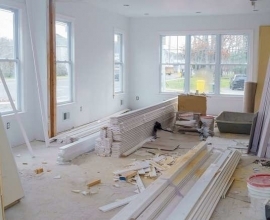The reason your remodel is probably behind schedule
FORT COLLINS, Colo. — Lynn Osborne has been remodeling two homes. They are different styles, in different states, with different contractors. But there has been one constant: delays due to a shortage of skilled labor.
The two-year remodel of her primary home in Fort Collins was to update and upgrade the ’90s house, and it included a small extension. It was completed last year, except for the landscaping, which is still under way.
That general contractor relied heavily on sub-contractors, she said, and sometimes they wouldn’t show, or would arrive days late, or did shoddy work and were fired.
Her remodel of an old family beach retreat in New England took a Sears kit home down to the studs. The completion date was June 2018, but it’s still not done because the contractor, who has been doing most of the work himself, is stretched and unattentive.
“He’d say, ‘I’ll be out there next week,’ and next week would turn into next month, and next month would be six months,” she said.
Current estimates indicate there are about 300,000 unfilled jobs in the construction industry, and the industry is expected to need an additional 747,000 workers by 2026, according to the U.S. Bureau of Labor Statistics.
An August survey of nearly 375 members of the National Kitchen and Bath Association found that almost two-thirds of the respondents said they had difficulties hiring skilled workers in the previous year, and nearly 70% felt the problem had gotten worse since 2016.
“Labor shortages have impacted start dates and completion dates on construction and renovation projects, with NKBA members citing delays on 30% of jobs,” said Bill Darcy, chief executive officer of the trade association.
A look at 15 different trades found shortages in them all, Darcy said in a telephone interview from NKBA headquarters in Hackettstown, New Jersey. And as with previous years, he said, one of the greatest needs was for carpenters, who do rough-in work and framing, and finish carpenters, who hang cabinets, do millwork, flooring and install molding.
Finding a quality finishing carpenter was one of the biggest frustrations in Osborne’s Fort Collins remodel.
“One guy got started on the basement and just left, so to find somebody to pick up where he left off was hard,” she said.
The seeds of the current labor shortage were planted during the Great Recession, when a lack of construction jobs prompted many workers to leave the industry.
The Home Depot Foundation announced last year it was committing $50 million to skilled trades training, with plans to attract 20,000 people by 2028.
“We want to bring shop class back, from coast to coast,” Shannon Gerber, executive director of the foundation, said in a release. The program focuses on supporting veterans, as well as underserved high schools.
Lowe’s last year started offering employees tuition and other incentives to train for jobs such as carpentry, plumbing, and appliance repair. More than 1,350 associates were enrolled in the Track to the Trades program this spring, Lowe’s spokeswoman Jennifer L. Weber said.
In April, Lowe’s and 60 of its suppliers and partners debuted a new program called Generation T , an online marketplace for jobs, apprenticeships and education programs in construction. It’s also on Twitter and Facebook.
Source: https://bit.ly/2LxFGWa







